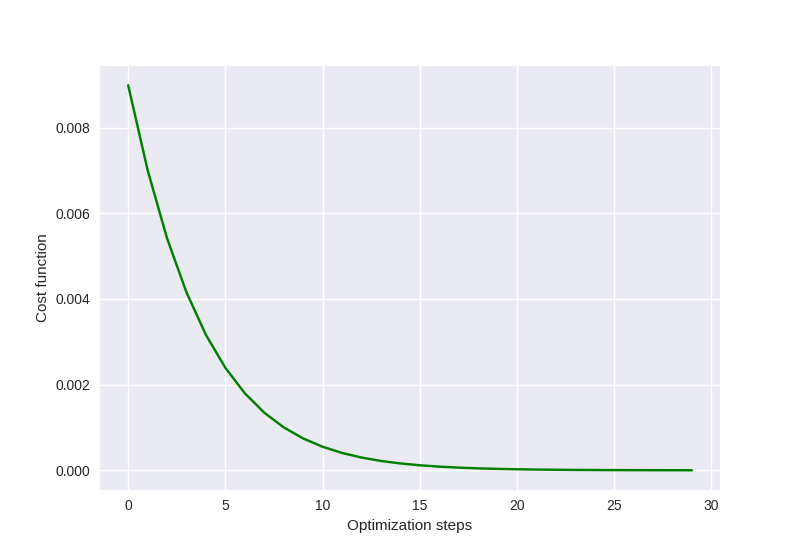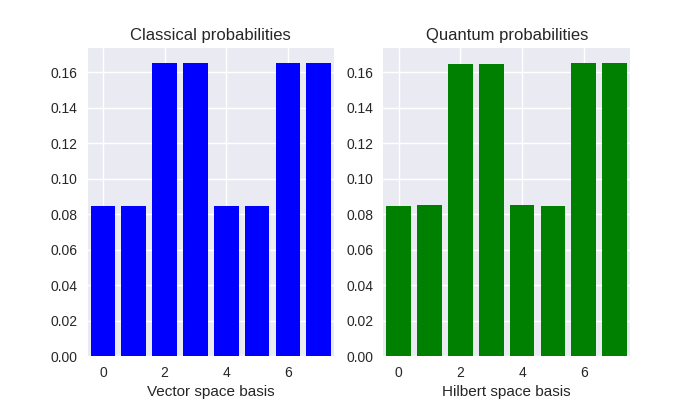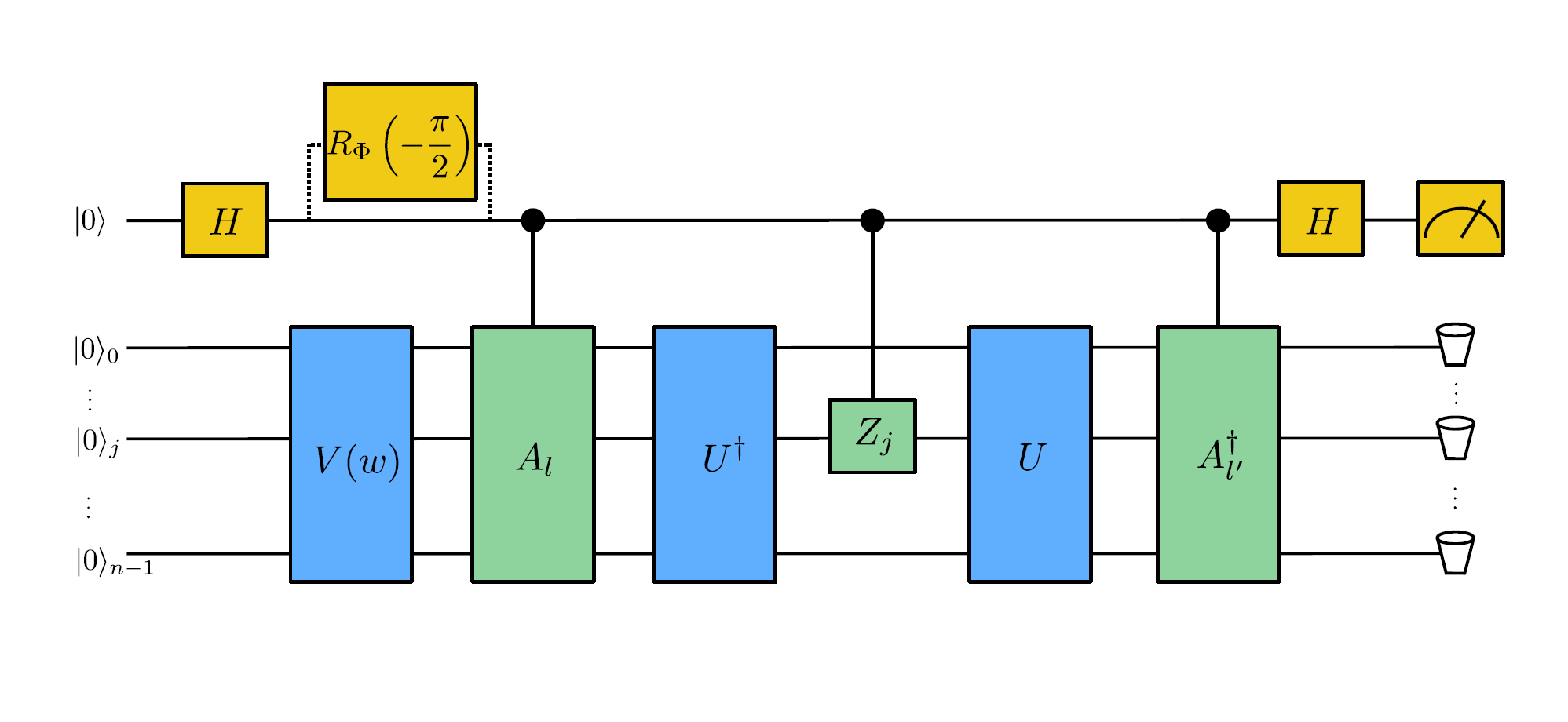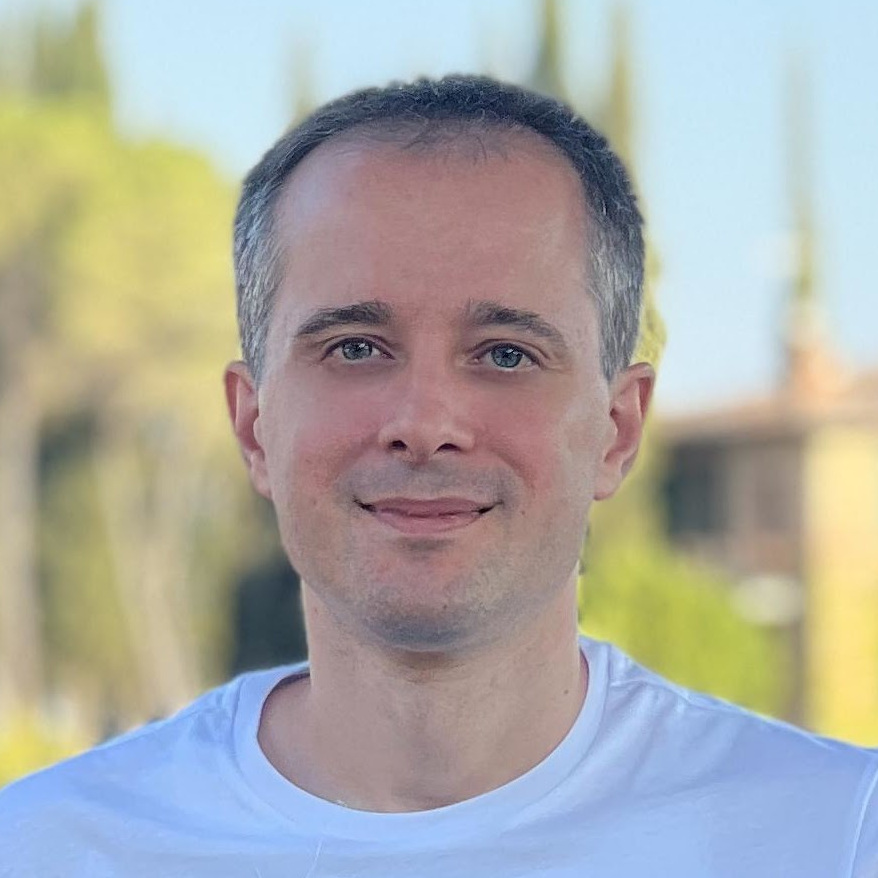Note
Click here to download the full example code
Variational Quantum Linear Solver¶
Author: Andrea Mari — Posted: 04 November 2019. Last updated: 20 January 2021.
In this tutorial we implement a quantum algorithm known as the variational quantum linear solver (VQLS), originally introduced in Bravo-Prieto et al. (2019).
Introduction¶
We first define the problem and the general structure of a VQLS. As a second step, we consider a particular case and we solve it explicitly with PennyLane.
The problem¶
We are given a \(2^n \times 2^n\) matrix \(A\) which can be expressed as a linear combination of \(L\) unitary matrices \(A_0, A_1, \dots A_{L-1}\), i.e.,
where \(c_l\) are arbitrary complex numbers. Importantly, we assume that each of the unitary components \(A_l\) can be efficiently implemented with a quantum circuit acting on \(n\) qubits.
We are also given a normalized complex vector in the physical form of a quantum state \(|b\rangle\), which can be generated by a unitary operation \(U\) applied to the ground state of \(n\) qubits. , i.e.,
where again we assume that \(U\) can be efficiently implemented with a quantum circuit.
The problem that we aim to solve is that of preparing a quantum state \(|x\rangle\), such that \(A |x\rangle\) is proportional to \(|b\rangle\) or, equivalently, such that
Variational quantum linear solver¶
The approach used in a VQLS is to approximate the solution \(|x\rangle\) with a variational quantum circuit, i.e., a unitary circuit \(V\) depending on a finite number of classical real parameters \(w = (w_0, w_1, \dots)\):
The parameters should be optimized in order to maximize the overlap between the quantum states \(|\Psi\rangle\) and \(|b\rangle\). This suggests to define the following cost function:
such that its minimization with respect to the variational parameters should lead towards the problem solution.
Now we discuss two alternative methods which could be used to experimentally solve the minimization problem.
First method¶
Let us write \(C_G\) more explicitly:
All expectation values of the previous expression could be estimated with a Hadamard test, which is a standard quantum computation technique. This method however might be experimentally challenging since it requires us to apply all the unitaries (\(U^\dagger, A_l\) and \(V\)) in a controlled way, i.e., conditioned on the state of an ancillary qubit. A possible workaround for estimating the same expectation values in a simpler way has been proposed in Ref. [1], but will not be considered here.
Second method¶
The second method, which is the one used in this tutorial, is to minimize a “local” version of the cost function which is easier to measure and, at the same time, leads to the same optimal solution. This local cost function, originally proposed in Ref. [1], can be obtained by replacing the blue-colored projector \(\color{blue}{|0\rangle\langle 0|}\) in the previous expression with the following positive operator:
where \(Z_j\) is the Pauli \(Z\) operator locally applied to the \(j\rm{th}\) qubit. This gives a new cost function:
which, as shown in Ref. [1], satisfies
and so we can solve our problem by minimizing \(C_L\) instead of \(C_G\).
Substituting the definition of \(P\) into the expression for \(C_L\) we get:
which can be computed whenever we are able to measure the following coefficients
where we used the convention that if \(j=-1\), \(Z_{-1}\) is replaced with the identity.
Also in this case the complex coefficients \(\mu_{l, l', j}\) can be experimentally measured with a Hadamard test. The corresponding quantum circuit is shown in the image at the top of this tutorial. Compared with the previous method, the main advantage of this approach is that only the unitary operations \(A_l, A_l^\dagger\) and \(Z_j\) need to be controlled by an external ancillary qubit, while \(V, V^\dagger, U\) and \(U^\dagger\) can be directly applied to the system. This is particularly convenient whenever \(V\) has a complex structure, e.g., if it is composed of many variational layers.
A simple example¶
In this tutorial we consider the following simple example based on a system of 3 qubits (plus an ancilla), which is very similar to the one experimentally tested in Ref. [1]:
where \(Z_j, X_j, H_j\) represent the Pauli \(Z\), Pauli \(X\) and Hadamard gates applied to the qubit with index \(j\).
This problem is computationally quite easy since a single layer of local rotations is enough to generate the solution state, i.e., we can use the following simple ansatz:
In the code presented below we solve this particular problem by minimizing the local cost function \(C_L\). Eventually we will compare the quantum solution with the classical one.
General setup¶
This Python code requires PennyLane and the plotting library matplotlib.
# Pennylane
import pennylane as qml
from pennylane import numpy as np
# Plotting
import matplotlib.pyplot as plt
Setting of the main hyper-parameters of the model¶
n_qubits = 3 # Number of system qubits.
n_shots = 10 ** 6 # Number of quantum measurements.
tot_qubits = n_qubits + 1 # Addition of an ancillary qubit.
ancilla_idx = n_qubits # Index of the ancillary qubit (last position).
steps = 30 # Number of optimization steps
eta = 0.8 # Learning rate
q_delta = 0.001 # Initial spread of random quantum weights
rng_seed = 0 # Seed for random number generator
Circuits of the quantum linear problem¶
We now define the unitary operations associated to the simple example presented in the introduction. Since we want to implement a Hadamard test, we need the unitary operations \(A_j\) to be controlled by the state of an ancillary qubit.
# Coefficients of the linear combination A = c_0 A_0 + c_1 A_1 ...
c = np.array([1.0, 0.2, 0.2])
def U_b():
"""Unitary matrix rotating the ground state to the problem vector |b> = U_b |0>."""
for idx in range(n_qubits):
qml.Hadamard(wires=idx)
def CA(idx):
"""Controlled versions of the unitary components A_l of the problem matrix A."""
if idx == 0:
# Identity operation
None
elif idx == 1:
qml.CNOT(wires=[ancilla_idx, 0])
qml.CZ(wires=[ancilla_idx, 1])
elif idx == 2:
qml.CNOT(wires=[ancilla_idx, 0])
Variational quantum circuit¶
What follows is the variational quantum circuit that should generate the solution state \(|x\rangle= V(w)|0\rangle\).
The first layer of the circuit is a product of Hadamard gates preparing a balanced superposition of all basis states.
After that, we apply a very simple variational ansatz
which is just a single layer of qubit rotations
\(R_y(w_0) \otimes R_y(w_1) \otimes R_y(w_2)\).
For solving more complex problems, we suggest to use more expressive circuits as,
e.g., the PennyLane StronglyEntanglingLayers() template.
def variational_block(weights):
"""Variational circuit mapping the ground state |0> to the ansatz state |x>."""
# We first prepare an equal superposition of all the states of the computational basis.
for idx in range(n_qubits):
qml.Hadamard(wires=idx)
# A very minimal variational circuit.
for idx, element in enumerate(weights):
qml.RY(element, wires=idx)
Hadamard test¶
We first initialize a PennyLane device with the default.qubit backend.
As a second step, we define a PennyLane QNode representing a model of the actual quantum computation.
The circuit is based on the Hadamard test and will be used to estimate the coefficients \(\mu_{l,l',j}\) defined in the introduction. A graphical representation of this circuit is shown at the top of this tutorial.
dev_mu = qml.device("default.qubit", wires=tot_qubits)
@qml.qnode(dev_mu, interface="autograd")
def local_hadamard_test(weights, l=None, lp=None, j=None, part=None):
# First Hadamard gate applied to the ancillary qubit.
qml.Hadamard(wires=ancilla_idx)
# For estimating the imaginary part of the coefficient "mu", we must add a "-i"
# phase gate.
if part == "Im" or part == "im":
qml.PhaseShift(-np.pi / 2, wires=ancilla_idx)
# Variational circuit generating a guess for the solution vector |x>
variational_block(weights)
# Controlled application of the unitary component A_l of the problem matrix A.
CA(l)
# Adjoint of the unitary U_b associated to the problem vector |b>.
# In this specific example Adjoint(U_b) = U_b.
U_b()
# Controlled Z operator at position j. If j = -1, apply the identity.
if j != -1:
qml.CZ(wires=[ancilla_idx, j])
# Unitary U_b associated to the problem vector |b>.
U_b()
# Controlled application of Adjoint(A_lp).
# In this specific example Adjoint(A_lp) = A_lp.
CA(lp)
# Second Hadamard gate applied to the ancillary qubit.
qml.Hadamard(wires=ancilla_idx)
# Expectation value of Z for the ancillary qubit.
return qml.expval(qml.PauliZ(wires=ancilla_idx))
To get the real and imaginary parts of \(\mu_{l,l',j}\), one needs to run the previous quantum circuit with and without a phase-shift of the ancillary qubit. This is automatically done by the following function.
def mu(weights, l=None, lp=None, j=None):
"""Generates the coefficients to compute the "local" cost function C_L."""
mu_real = local_hadamard_test(weights, l=l, lp=lp, j=j, part="Re")
mu_imag = local_hadamard_test(weights, l=l, lp=lp, j=j, part="Im")
return mu_real + 1.0j * mu_imag
Local cost function¶
Let us first define a function for estimating \(\langle x| A^\dagger A|x\rangle\).
We can finally define the cost function of our minimization problem. We use the analytical expression of \(C_L\) in terms of the coefficients \(\mu_{l,l',j}\) given in the introduction.
def cost_loc(weights):
"""Local version of the cost function. Tends to zero when A|x> is proportional to |b>."""
mu_sum = 0.0
for l in range(0, len(c)):
for lp in range(0, len(c)):
for j in range(0, n_qubits):
mu_sum = mu_sum + c[l] * np.conj(c[lp]) * mu(weights, l, lp, j)
mu_sum = abs(mu_sum)
# Cost function C_L
return 0.5 - 0.5 * mu_sum / (n_qubits * psi_norm(weights))
Variational optimization¶
We first initialize the variational weights with random parameters (with a fixed seed).
np.random.seed(rng_seed)
w = q_delta * np.random.randn(n_qubits, requires_grad=True)
To minimize the cost function we use the gradient-descent optimizer.
opt = qml.GradientDescentOptimizer(eta)
We are ready to perform the optimization loop.
Out:
Step 0 Cost_L = 0.0089888
Step 1 Cost_L = 0.0070072
Step 2 Cost_L = 0.0054157
Step 3 Cost_L = 0.0041528
Step 4 Cost_L = 0.0031617
Step 5 Cost_L = 0.0023917
Step 6 Cost_L = 0.0017988
Step 7 Cost_L = 0.0013461
Step 8 Cost_L = 0.0010028
Step 9 Cost_L = 0.0007442
Step 10 Cost_L = 0.0005503
Step 11 Cost_L = 0.0004058
Step 12 Cost_L = 0.0002984
Step 13 Cost_L = 0.0002190
Step 14 Cost_L = 0.0001604
Step 15 Cost_L = 0.0001173
Step 16 Cost_L = 0.0000857
Step 17 Cost_L = 0.0000625
Step 18 Cost_L = 0.0000455
Step 19 Cost_L = 0.0000331
Step 20 Cost_L = 0.0000241
Step 21 Cost_L = 0.0000175
Step 22 Cost_L = 0.0000127
Step 23 Cost_L = 0.0000092
Step 24 Cost_L = 0.0000067
Step 25 Cost_L = 0.0000049
Step 26 Cost_L = 0.0000035
Step 27 Cost_L = 0.0000026
Step 28 Cost_L = 0.0000019
Step 29 Cost_L = 0.0000013
We plot the cost function with respect to the optimization steps. We remark that this is not an abstract mathematical quantity since it also represents a bound for the error between the generated state and the exact solution of the problem.
plt.style.use("seaborn")
plt.plot(cost_history, "g")
plt.ylabel("Cost function")
plt.xlabel("Optimization steps")
plt.show()

Comparison of quantum and classical results¶
Since the specific problem considered in this tutorial has a small size, we can also solve it in a classical way and then compare the results with our quantum solution.
Classical algorithm¶
To solve the problem in a classical way, we use the explicit matrix representation in terms of numerical NumPy arrays.
We can print the explicit values of \(A\) and \(b\):
Out:
A =
[[1. 0. 0. 0. 0.4 0. 0. 0. ]
[0. 1. 0. 0. 0. 0.4 0. 0. ]
[0. 0. 1. 0. 0. 0. 0. 0. ]
[0. 0. 0. 1. 0. 0. 0. 0. ]
[0.4 0. 0. 0. 1. 0. 0. 0. ]
[0. 0.4 0. 0. 0. 1. 0. 0. ]
[0. 0. 0. 0. 0. 0. 1. 0. ]
[0. 0. 0. 0. 0. 0. 0. 1. ]]
b =
[0.35355339 0.35355339 0.35355339 0.35355339 0.35355339 0.35355339
0.35355339 0.35355339]
The solution can be computed via a matrix inversion:
Finally, in order to compare x with the quantum state \(|x\rangle\), we normalize and square its elements.
Preparation of the quantum solution¶
Given the variational weights w that we have previously optimized,
we can generate the quantum state \(|x\rangle\). By measuring \(|x\rangle\)
in the computational basis we can estimate the probability of each basis state.
For this task, we initialize a new PennyLane device and define the associated qnode circuit.
dev_x = qml.device("default.qubit", wires=n_qubits, shots=n_shots)
@qml.qnode(dev_x, interface="autograd")
def prepare_and_sample(weights):
# Variational circuit generating a guess for the solution vector |x>
variational_block(weights)
# We assume that the system is measured in the computational basis.
# then sampling the device will give us a value of 0 or 1 for each qubit (n_qubits)
# this will be repeated for the total number of shots provided (n_shots)
return qml.sample()
To estimate the probability distribution over the basis states we first take n_shots
samples and then compute the relative frequency of each outcome.
raw_samples = prepare_and_sample(w)
# convert the raw samples (bit strings) into integers and count them
samples = []
for sam in raw_samples:
samples.append(int("".join(str(bs) for bs in sam), base=2))
q_probs = np.bincount(samples) / n_shots
Comparison¶
Let us print the classical result.
print("x_n^2 =\n", c_probs)
Out:
x_n^2 =
[0.08445946 0.08445946 0.16554054 0.16554054 0.08445946 0.08445946
0.16554054 0.16554054]
The previous probabilities should match the following quantum state probabilities.
print("|<x|n>|^2=\n", q_probs)
Out:
|<x|n>|^2=
[0.084589 0.085022 0.164642 0.164879 0.085241 0.084731 0.165431 0.165465]
Let us graphically visualize both distributions.
fig, (ax1, ax2) = plt.subplots(1, 2, figsize=(7, 4))
ax1.bar(np.arange(0, 2 ** n_qubits), c_probs, color="blue")
ax1.set_xlim(-0.5, 2 ** n_qubits - 0.5)
ax1.set_xlabel("Vector space basis")
ax1.set_title("Classical probabilities")
ax2.bar(np.arange(0, 2 ** n_qubits), q_probs, color="green")
ax2.set_xlim(-0.5, 2 ** n_qubits - 0.5)
ax2.set_xlabel("Hilbert space basis")
ax2.set_title("Quantum probabilities")
plt.show()

References¶
Carlos Bravo-Prieto, Ryan LaRose, Marco Cerezo, Yigit Subasi, Lukasz Cincio, Patrick J. Coles. “Variational Quantum Linear Solver: A Hybrid Algorithm for Linear Systems.” arXiv:1909.05820, 2019.

